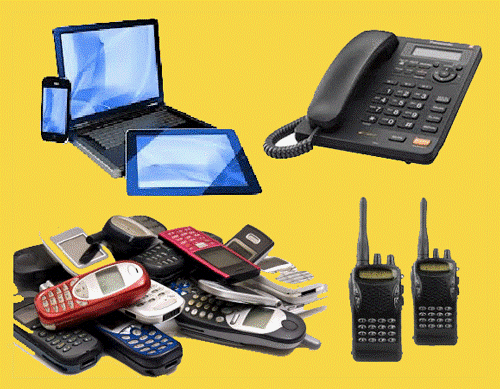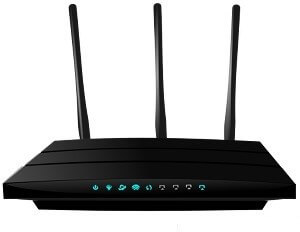What is Communication Device?Any hardware that can send and receive data, instructions, and information is referred to as a communications device. A modem is one kind of communication tool that joins a channel to a sending or receiving device, like a computer. Data is processed by computers as digital signals. Depending on the communications channel, data, instructions, and information can move along it in analogue or digital form. An electrical wave that is continuous makes up an analogue signal. Individual electrical pulses that represent bits and bytes are what make up a digital signal. 
The modem transmits digital signals between the computer and the communications channel for channels that employ digital signals (such as cable television lines). However, the modem must first convert between analogue and digital signals if the communication channel uses analogue signals (such as some telephone lines). Communication device examplesA complete list of every form of communication device you might use with a computer can be found below: 1. Bluetooth device: The Bluetooth specification outlines how devices can connect with one another in the computing and telecommunications industries. Computers, a keyboard and mouse, personal digital assistants, and smartphones are examples of devices that use Bluetooth. Bluetooth is an RF technology that runs at 2.4 GHz, has a throughput of 721 kbps, a transfer rate of 1 Mbps, and a variable effective range of 32 feet depending on the power class (10 meters). 2. Infrared device: It is a technique for data transport without the usage of cables. A TV remote is a typical illustration of an infrared (Ir) gadget. But infrared is also employed by computers and gadgets like cordless keyboards, mice, and touch screens. 3. Smartphone: A smartphone is a cell phone that offers more features than just texting and calling. Smartphones have the ability to use software just like a PC and browse the Internet. Smartphones have touch screens that enable user interaction. Numerous apps for smartphones, including games and apps for personal and professional use, are available. The Apple iPhone, one of the most well-known smartphones on the market today, is shown in the image as an example. 4. Wi-Fi device: Wi-Fi is a wireless network that connects to a network wirelessly by using one of the IEEE 802.11 wireless standards. A wireless access point or router is used in a home wireless network to broadcast a signal while encrypting it with WAP or WEP to send and receive data from wireless devices connected to the network. 5. Network interface card: The NIC, which stands for network interface card, is also known as an Ethernet card and a network adapter. An Ethernet cable with an RJ-45 connector is used to connect a computer to a network (such as your home network or the Internet) using a NIC. The Ethernet standard is so common and inexpensive that almost all modern computers come with a network port built right into the motherboard. One of the more typical examples is the SMC EZ Card 10/100 PCI network card, which is shown in the top image. Types of Communication DeviceThere are the following types of Communication devices: 
1. Dial-up Modem: As was previously said, digital signals from a computer must be converted to analogue signals before being sent over regular telephone lines. This conversion is carried out by a modem, often known as a dial-up modem, which is a communications device. The phrase modulation, which turns a digital signal into an analogue signal, and demodulates, which change an analogue signal into a digital signal, are combined to form the word modem. A modem typically takes the shape of an adapter card that you place in an expansion slot on the motherboard of a computer. A normal telephone cord has two ends: one plugs into a port on the modem card and the other into a phone outlet. 2. ISDN and DSL Modems: You require a communications device to transmit and receive the digital signals from the provider if you use ISDN or DSL to access the Internet. A computer's digital data and information can be transmitted to and received from an ISDN connection using an ISDN modem. A DSL modem transfers and receives digital data and information over a DSL line, both from a computer and another device. Typically, ISDN and DSL modems are external devices that connect to a port on the system unit at one end and the telephone line at the other. 3. Cable Modems: A cable modem transmits and receives digital data. Cable modems offer a speedier option to dial-up for home users and have speeds comparable to DSL because more than 110 million households are wired for cable television. Compared to dial-up modems and ISDN, cable modems can currently transport data at speeds that are substantially quicker. 4. Wireless Modems: Some mobile users have a wireless modem that connects to the Internet wirelessly from a laptop computer, a Smartphone, or another portable device. There are external or built-in wireless modes.ms that come in PC Cards, ExpressCard modules, and flash memory card formats. 5. Network Cards: A network card, often referred to as an adapter card, PC Card, ExpressCard module, USB network adapter, or flash card, enables a computer or other device without networking capability to connect to a network.The network card controls how data, commands, and information are sent and received to and from the computer or device that it is installed. There are many different types of network cards. A desktop computer's network card is an adapter card with a port where a cable can be connected. Network cards for portable computers and devices include things like flash cards, PC Cards, ExpressCard Modules, and USB Network Adapters.There are also network cards that enable wireless data transmission. Oftentimes, this kind of card - also known as a wireless network card - has an antenna. An Ethernet or token ring network card complies with the rules of a specific network communications standard. The most popular kind of network card is an Ethernet card. 6. Wireless Access Points: A wireless access point is a hub for communications that enables computers and other devices to communicate wirelessly with one another or wirelessly with a wired network. For the best signal reception, wireless access points include high-quality antennas. 7. Routers: A router is a communications tool that links several computers or other routers and sends data to the right location on the network. Any size of a network can use a router. On a broad scale, routers lining the backbone of the Internet forward data packets to their destination via the quickest route. A router enables several computers to share a single high-speed Internet connection, such as a cable modem or DSL modem, for smaller corporate and residential networks. From two to 250 computers are connected using these routers. A hardware firewall, which is a common security feature on routers, prevents unauthorized users from accessing data and computers.Some also feature integrated antivirus defense. Modern routers and wireless access points/routers are simple to set up and safe from unauthorized access. Communication device errorsYou could have a communication error whenever a communication device has trouble connecting with another device. The general steps that can be checked when this problem occurs are listed below.
Why do computers need communication devices?A computer can operate normally without a communication device. But in order to talk to other computers, it needs a communication tool. For instance, your computer needs a connection device in order to connect to the Internet and view this website. To transfer or distribute data between computers, you would need a sneaker net if there was no communication method. Advantages of the communication device1. A person with a disability's world can change thanks to communication technologies. Through a communication gadget, the capacity to articulate needs, wants, and personality can be rewarded. Young children who receive these gadgets have a wider view to the outside world. 2. One of the main reasons people utilize electronic communication devices is convenience. The use of the Internet and mobile devices for communication comes with a higher level of comfort. Compared to sending mail through the postal service, email allows you to deliver communications without a lot of movement or effort. The Internet is a great place to find anything you need because it is filled with resources like books, magazines, and online shops. Cell phones are a source of convenience since they let you call anyone at any time, no matter how far away they are. 3. People who have not accessed to other forms of communication can simply use electronic communication devices. People who have never possessed a house telephone now have cell phones in emerging nations. Cell phones are also developing quickly. There are many options available now that offer three or four different methods to interact, including traditional phone connections, Internet connections, as well as text messaging. |
 For Videos Join Our Youtube Channel: Join Now
For Videos Join Our Youtube Channel: Join Now
Feedback
- Send your Feedback to [email protected]
Help Others, Please Share










